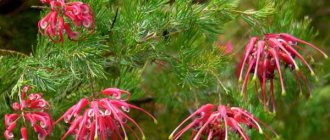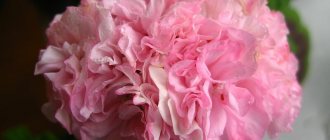What is the attractiveness of the plant? And how to grow coleus from seeds?
The main feature of the numerous varieties and varieties of herbaceous plants ranging in height from 30 to 50 cm is the decorative pointed-ovate foliage of incredible colors.
The leaves, sitting on pubescent, succulent stems, can have such a bright and variegated color that even beautifully flowering species will envy the abundance of shades. For coleus, revered by lovers of indoor and garden crops, it is not at all uncommon not only to have green or yellowish-white tones, but also such exotic colors as lilac, crimson, brown, purple and pink. In many varieties, the leaves are decorated with spots, stripes, and a wide or narrow edging along the edge.
At the same time, growing coleus will not be difficult even for beginners in floriculture, and with minimal care, the bright, unpretentious plant will delight the eye for a long time both outdoors and indoors.
Description
In nature, coleus has about 60 varieties. The ancestor of all cultivated varieties was the Blume species. Popularly, the herbaceous plant is also called “nettle” due to the similarity of the leaves to nettles. Breeders have developed many hybrids that are distinguished by a variety of foliage colors and patterns on it in the form of spots and stripes. The most decorative varieties are especially common among gardeners:
- Rainbow;
- Fun;
- Fantasy;
- Black dragon;
- Dark chocolate.
There is "Dog Coleus" - a variety with an unpleasant aroma that discourages pets from encroaching on the plant. The varieties Jade, Faust, and Watermelon will surprise even experienced flower growers with their unusual shades.
The flower grows from 35 to 50 cm in height. The ribbed stems become lignified near the ground, but at the ends they are soft and almost transparent. The foliage is velvety, with serrated edges, and varies in size depending on the species. The flowers are small and inconspicuous, and the bright leaves are colored in shades of green, purple, white, burgundy, yellow, and brown.
Types, varieties
Coleus as a crop has been developing relatively recently. In Europe, starting from the 19th century, the varieties Blume and Verschaffelt have been distributed. In Russia, coleus appears later.
The most famous decorative varieties: black dragon, blue, dark chocolate, rainbow, fantasy, magical sunset, underwater world and others. The names already give an idea of what the bush will look like. The variety of types and varieties makes it possible to choose a variety of decorative options for any discerning taste.
Timing of sowing seeds
Early spring is the best time to sow seeds for seedlings. The best time to do this is in March. Seeds from Dutch and English breeders can be sown indoors at any time of the year, but to grow a full-fledged beautiful flower you will need additional lighting on short winter days.
In regions with a warm and mild climate, the end of February and the beginning of March is the ideal time to sow coleus. Seedlings are planted in a permanent place in the garden in early May, when night temperatures do not drop below +15°C.
In the temperate climate of central Russia, sowing is carried out in mid-March. They are planted on the site in the second half of May, when there is no longer a threat of spring frosts.
In areas with a cold and changeable climate, coleus is sown in the second ten days of March. Seedlings are planted in open ground at the end of May, when warm weather sets in.
Features of growing seeds
Growing beautiful plants from seeds is fun and easy. You can assemble them yourself, purchase them in a specialized store, or use the services of an online store. The choice of different varieties is wide.
The seeds externally resemble large poppy seeds, the difference being their faceted shape. Amateur gardeners who are starting to breed this species are better off choosing a popular variety, and then, as they gain experience, they can choose more exotic varieties.
One package usually contains about 20 pieces of planting material, which germinates well. The sprouts quickly grow in height and become stronger.
Attention! There are some features that must always be remembered and taken into account when growing. Coleus loves light and warm air. Moreover, the light is preferably natural, so the seeds are planted in the spring, possibly earlier.
Sprouts develop well in such conditions, become stronger and grow quickly. In autumn or winter, success will be more difficult to achieve. Spring, thanks to the increase in daylight hours, allows you to do without lighting and creating special conditions for warming the space.
Capacity requirements
Wooden boxes are the most suitable container for sowing seeds. Moreover, the sides do not have to be high - 8-10 cm is enough. The wider the width, the better.
Plastic containers have similar parameters. A prerequisite is the presence of holes in the bottom to drain excess moisture. A drainage layer is laid under the soil. The soil itself is not compacted or compressed. The distance from the ground surface to the edge of the side should not exceed 2 cm.
Step-by-step instructions for planting basil seedlings
In order to grow good seedlings, which will then take root well in the soil and amaze with their magnificent appearance and taste, you must initially correctly plant basil seeds for seedlings at home.
Seed selection and preparation
A simple but important trick will help you choose good and high-quality planting material - buy seeds in reliable stores and sales points with good reviews and from trusted manufacturers.
What seed material is better not to buy? The one that has damaged, wrinkled, dirty packaging (perhaps the product was stored incorrectly and germination rate will decrease because of this), as well as suspiciously cheap products.
The seeds of this crop germinate well without pre-sowing treatment. However, if you want to get faster and more friendly shoots, you can treat them with a growth stimulator, for example, Epin-Extra, Zircon. You need to soak the seeds according to the instructions on the package.
As you can see in the photo, basil seeds swell when soaked and look very interesting:
Soil preparation
In order for growing basil seedlings at home to be most successful, you should choose a suitable substrate. The culture prefers fertile, loose, light, air- and water-permeable soil.
You can plant the seeds in purchased soil; universal soil for vegetable seedlings is suitable. Or you can cook it yourself.
If you want to prepare soil at home with your own hands, then you should mix the following ingredients in equal proportions:
- soil from the garden;
- peat;
- humus.
You can make a soil mixture according to the following recipe:
- clean river sand (1 part);
- peat (4 parts);
- humus or compost (2 parts).
Selection of capacity
If you do not plan and do not want to plant seedlings, then you can plant basil seeds in large single containers, for example, peat tablets, pots, plastic cups. Their volume is 0.5 l. You can sow in smaller cups (0.2 l), and then also dive into larger ones.
Or you can sow basil in a common container - a wooden or plastic box, or some kind of bowl. If the planting is denser, subsequent picking will be required. But if the container was initially chosen to be deep and wide and a large distance was maintained between the seeds (7-10 centimeters), then you can do without picking.
Direct sowing
Let's look at detailed instructions for planting seeds for seedlings at home with step-by-step photographs that describe all stages:
Step 1: Create drainage.
Place a layer of drainage 1-1.5 centimeters thick on the bottom of the planting container. It will eliminate moisture stagnation, which basil really doesn’t like. You can use perlite, broken brick, expanded clay (as in the photo below):
Step 2: Fill the container with soil.
Leave a small distance between the edges of the container and the ground.
Level the surfaces and compact them very lightly with your hand.
Step 3: Watering the soil.
Moisten the soil with a spray bottle with warm, clean water.
Step 4: Direct sowing of basil seedlings.
When sowing seeds in a common box or bowl, it is practical to sow them in furrows.
To do this, make grooves (very convenient using a ruler). The depth of the rows is 5 millimeters, the distance between them is 3 centimeters (if you have a large container, you can increase the distance to 5-7 cm).
Spread the seeds on the surface, the distance between the seeds is 3 centimeters (if you have a wide box, then plant with a gap of 5-7 cm).
Can be planted using fingers.
Or you can use tweezers.
You need to plant basil seedlings in individual containers as follows (plastic cassettes in the photo):
Make a depression with your finger or pencil, depth - 3-5 millimeters, no more.
Sow two seeds per hole. You can also do this with your hands or tweezers.
Step 5: Cover the seeds with soil.
Now you should sprinkle the seeds in the hole with soil. Layer - 0.5 centimeters (but no more).
Step 6: Water after sowing.
The soil with seeds should be moistened exclusively with a spray bottle; water can only be used that has settled, clean, and at room temperature.
Step 7: Create a mini greenhouse.
A greenhouse is needed to create the optimal conditions necessary for seed germination. To do this, cover the container with glass, a lid, or film.
And then put it in a dark and warm room with a temperature of 23-24 degrees Celsius.
Step 8: Label the seedlings somehow.
For example, attach a sticker.
Pre-planting seed preparation
A prerequisite for obtaining strong seedlings is seed disinfection. Planting material is disinfected as follows:
- Add a few crystals of potassium permanganate to a container of warm water until the liquid turns light pink.
- Pour the seeds into the water, making sure that they are submerged evenly.
- Leave for 15 minutes.
- Drain the water.
- The seeds are dried on a piece of cloth until they begin to separate well from each other.
The germination rate of coleus is about 50%.
Sowing technology
The seeds of decorative nettle are small, like poppy seeds, so the process is performed carefully.
Perform the following steps step by step:
- Treat the seeds with a weak solution of manganese or another fungicide, if they were not purchased at the store. They are immersed in liquid for 10 minutes, then dried, being sure to separate them. For purchased planting material, the procedure is not necessary.
- The seedling box is filled with substrate, having previously poured drainage into an even layer on the bottom - expanded clay or fine pebbles, broken brick. The soil is not compacted so that the grains do not suffer from lack of air.
- Each seed must be sown separately. It is convenient to use a regular match for this, slightly moistening its tip.
- There is no need to cover the crops. Even the thinnest layer of soil will delay the emergence of seedlings.
- Moisten the nursery with a fine spray bottle. This will prevent unwanted seed burial.
- The container is covered with glass or transparent film and placed in a warm, well-lit place. The optimal temperature is +23…+25 °C.
The crops are ventilated daily for 30 minutes, and drops of water are removed from the film. If necessary, additional irrigation is carried out. The first shoots appear after 10-15 days.
Conditions for seed germination
The greenhouse atmosphere created by the efforts of the gardener will reduce the time for the first shoots to appear. The quality of the seed also affects the timing of germination.
Lighting and location
The length of daylight hours does not matter until the seeds have sprouted. At this stage, it is more important to ensure an even temperature without sudden changes.
A good place for seedlings is a windowsill that is illuminated by diffused light. The corner of a table located by the window is also a suitable option.
Temperature
In the room where the containers with planted coleus are located, maintain a temperature of at least +22°C, +25°C. The first shoots will appear within a week if the seeds are good. If after two weeks of waiting nothing has hatched, you should not wait for germination - it means that the planting technology was violated or the seeds were bad.
Air and humidity
Mandatory daily ventilation will avoid waterlogging and provide oxygen to the seeds. To do this, the film or glass is opened for a few minutes. The air in a city apartment, dried out by radiators, is moistened by periodically spraying water next to the boxes.
Watering
It is necessary to moisten the soil as the surface layer dries. This is done only with a spray bottle, very carefully. You need to spray water a little at a time so that drips do not wash the seeds deep into the ground. Too much liquid pressure can knock the seeds into heaps or cover them with soil, preventing them from germinating.
Plant propagation methods
There are two methods of reproduction:
- cuttings;
- using seeds.
Getting a lush bush is a matter of time; it will need to be trimmed and pinched. Cut parts - cuttings - are used for propagation.
They are placed in water, waiting for roots to appear. Another option is to mix sand and sphagnum, dig the cutting into the resulting mixture, after moistening it with water. The roots appear in about a week, then the cuttings can be transplanted into individual containers.
Attention! It is interesting to grow several types of coleus at once. Then you can plant diverse bushes side by side in a large container or in a flower bed, ridge, and so on. In this case, a combination of different shades will give an original color design.
The seedlings are planted at a distance of approximately 15 cm, and constant pruning is used to achieve a rounded shape of the bushes. Such balls will decorate an apartment, house, or flower garden.
Seedling care
When sprouts appear from about 50% of the seeds, remove the film or glass from the containers. Small sprouts are actively developing, and if the conditions are suitable, the seedlings will turn out strong and strong.
Temperature
To prevent plants from slowing down their growth rate, the temperature regime is maintained from +21°C to +23°C. Changes and sudden jumps should not be allowed; coleus reacts by weakening the immune system when it gets cold, and in the heat it becomes very stretched and frail.
Backlight
After the seeds have hatched, the plant needs good lighting. Seedlings need bright, but not burning light for at least 15 hours a day. This is why additional sources are used when the day is short. Sunlight should be intense, but diffused, not hot.
Watering
Water the seedlings carefully, spraying water from a spray bottle. Young coleus have weak roots; strong pressure can wash the plant out of the ground along with the root system. You cannot over-wet the soil - only a dry surface serves as a signal that watering is needed. Stagnation of water provokes the appearance of “black leg” and other infections.
Picking
Picking is carried out 3-4 weeks after emergence. As soon as the leaves of small coleus begin to come into close contact with each other, they need to be planted in separate containers, giving space to the root system.
Diving is carried out with a narrow (no more than 3 cm in width) spatula with a long pointed tip. This tool allows you to carefully pry up the seedlings without damaging the roots and neighboring sprouts. At the same time, they try not to shake off the lumps of earth from the roots, replanting with them.
The cups are prepared in advance - filled with soil and watered. The soil is the same as for sowing seeds.
Top dressing
Wood ash, ground into powder, scatters over the surface already in the first days after the sprouts appear. This is not only plant fertilization, but also disease prevention. 2 weeks after picking, the first feeding with minerals is carried out. Small seedlings are fertilized with complex additives, making the solution weaker than indicated in the instructions. Uniflor (1 ml per 1 liter of water), Fertika Lux (15 g per 1 sq. m.), Zdraven (5 g per 10 liters of water) will help with active growth.
Pinching
To ensure that the flower grows a lush leafy mass, and does not stretch into height as a skinny bush, the crown is pinched. The procedure is carried out for the first time after 2 months from the date of germination, when the seedling reaches a height of at least 10 cm.
Using the nails of the index and thumb, pinch off the upper part of the stem. At the same time, the side shoots begin to develop more intensively, forming a voluminous crown.
Growing in peat tablets
Peat tablets are first filled with warm water so that they swell. After draining the unnecessary liquid, the seeds are placed on the surface one by one. Keep a distance of at least 2 cm from each other.
The tray with tablets is covered with film. Moistening is carried out as it dries. To do this, use a pharmaceutical pipette - 2-3 portions of water from it are enough for watering, and the seeds will not be washed away by the liquid.
The seeds are ventilated daily, lifting the film. When the seeds hatch, the ventilation time is gradually increased, hardening the seedlings. To moisturize, pour water into a tray with tablets every 3-4 days, the required amount is absorbed by peat.
Grown seedlings are transplanted into separate containers when they become crowded. To do this, the retina is carefully cut with scissors. Small coleus are removed, being careful not to damage the roots, and planted in cups with soil.
Diseases and pests
Coleus is quite unpretentious and rarely gets sick. But to prevent “black leg,” an infection destructive to seedlings, the following measures are taken:
- Before planting, the soil is spilled with boiling water or a weak solution of potassium permanganate;
- at the first signs of infection, water with a fungicide solution, removing all affected seedlings;
- provide good ventilation in the room;
- do not over-moisten the soil, watering when the top layer of soil is completely dry.
Among the preparations used are Fundazol (5 g per 10 liters of water), Previkur (3 ml per 2 liters of water), Profit Gold (0.5-1 g per 1 liter of water).
Direct rays of the sun lead to burns on coleus leaves and discoloration of the leaves. If the air is too dry, brown spots appear on the foliage - in hot weather, this sign means that the plant needs regular spraying.
Among the pests you should be wary of are aphids, whiteflies, and spider mites. The fight against parasites gives results if carried out correctly:
- Isolate the box with infected seedlings from others.
- Remove damaged leaves and destroy them.
- If you give your seedlings a warm shower, you can do it with a soapy solution.
- Thin out too many plantings.
- Treat with insecticides if previous measures did not help. They use Aktara, Confidor, Akarin, Iskra.
Forum, reviews
Growing coleus from seeds at home is a fascinating activity. Cultivation does not require special skills, does not require much time and effort to care for, and is suitable for beginner gardeners. It will delight you with bright, original flowers and will look great in a pot on the windowsill, in a flowerbed among other flowers, on alpine hills, next to ponds.
Review: - The plant is excellent, the succulent leaves of different colors have become a decoration for my site. Planted along the paths and near the gazebo. It turned out very elegant. Next year I plant again...
Review: — I recommend growing coleus from seeds. If you mix planting material from several bags, you will get a great surprise when the foliage gradually turns different colors, and it will be interesting to guess what will happen in the end. By the way, it’s a good savings if you take the seeds and grow them yourself, rather than buying ready-made seedlings.
Further care
In order for coleus to please the eye with lush, bright foliage, you need to choose the right place for planting in the garden or placing a pot - with good lighting, but without intense sunlight. Regular watering and pinching will allow you to grow bushes that will become a real decoration of your site or home.
Watering
The plant easily tolerates a slight drought, but a constant lack of moisture affects its development and appearance - coleus grows poorly, and the leaves look lethargic and faded. It should be remembered that waterlogging is worse for nettles than dry soil - excess water leads to rotting of the roots and death of the entire plant.
The need for watering is checked by pressing a finger on the surface of the soil. If your finger remains dry even after intense pressure, you need to water the plants. If moisture is felt under the top layer of soil, moisturizing is not yet required.
The leaves should not be wiped as this will damage the leaves and cause them to die. Spraying is a desirable procedure, and in the hot dry season it is necessary to spray the plant.
It is better to use settled water at room temperature. For garden plantings, you can collect rainwater.
The period of active growth for coleus practically never ends. The flower grows luxuriantly in winter, in warm rooms, so the intensity of soil moisture does not decrease. If the room temperature drops to +10 in winter, watering is halved, since growth stops.
Top dressing
Nettle is a fast-growing crop, so it needs constant feeding. After planting in a permanent place, the coleus is fertilized every week. At the beginning of summer, complexes with nitrogen are used to increase the growth of leaf mass. Bio Master (5 ml per 10 liters of water) is suitable.
Throughout the season, use Aquarin (2.5 g per 1 liter of water), Magic Watering Can (10 ml per 5 liters of water). In winter, indoor flowers are fertilized less often, once a month.
Loosening
It is necessary to ensure access of oxygen to the roots by loosening the top layer of soil, which is carried out after each watering. In the garden plot, the procedure is combined with the removal of weeds and debris. Mulching open ground with humus will help prevent intense evaporation of moisture in the heat and ensure the supply of useful substances to the soil.
Pinching
Be sure to carry out the procedure if you want to grow a compact, lush bush with voluminous, dense foliage. The central trunk is pinched at a height of 10-15 cm. Then, regularly, throughout the warm season, the tops of the side shoots are pinched off if their length is more than 4 cm. The crown is formed as desired.
Be sure to remove the panicles of the inflorescences so that the plant does not waste energy on flowering. You can prevent the appearance of flowers by pinching off emerging young shoots with flower stalks. To renew the nettle in February, the indoor flower is cut to a stump, leaving only 5-6 growth points on the trunk.
Transfer
The pots of coleus plants that grow in the house need to be changed as the bush grows. This is done by transshipment every 2-3 years. Buy a container larger in volume than the one in which the flower grew. Signs of the need for a transplant:
- cessation of growth;
- crushing leaves;
- faded color;
- Potted soil that dries out too quickly.
Plants in the garden need to be replanted if the plantings are too thick and the bushes interfere with each other and their care. When the distance between plants is less than 30 cm, they are carefully dug up with a lump of earth and transplanted to another place.
Growing coleus from seeds in open ground
It is possible to grow coleus on a plot by planting seeds in open ground only in the mild climate of the southern regions. In central Russia there is not enough time in the warm season for flowers to grow into full-fledged plants.
In areas with warm winters and early spring, seeds are laid out in beds evenly over the ground in late March-early April, without deepening them. Cover with film for 1-2 weeks, maintaining the temperature at least +22°C. At first, moisten the soil with a spray bottle. Young plants are planted after 1-1.5 months, in a permanent place, in flower beds.
Coleus in winter
As already mentioned, garden coleus is most often grown as an annual. If you are sorry to part with it, dig up a bush, replant it in a pot, bring it into the house and care for it like a houseplant: gradually reduce watering towards winter, and fertilize once a month. You should also care for indoor coleus. In winter, in addition to reducing watering, the temperature of the coleus should also be reduced to 8-15 ºC.
In the photo: Coleus flower / Coleus Beaute de Lyon
Adviсe
Leaves falling off and their color becoming pale occurs due to lack of nutrition. It is enough to water it with a solution of complex fertilizer and the flower will again acquire a decorative, attractive appearance.
Softened leaves and stems that have lost their elasticity indicate waterlogging of the soil. In this case, drainage is added under the soil layer, and looser bulk elements are added to the soil composition: sand, humus, peat.
A plant severely affected by disease or parasites can be saved by cutting off the most surviving shoots. The cuttings quickly send out roots in water and take root easily, developing intensively after transplanting into the soil.
Possible problems
Danger to the crop are: whitefly, spider mites and aphids.
To combat aphids, use a soap solution
Treat the above-ground part of the plant, repeating the procedure every other week if the pests survive. Before starting manipulations, cover the soil in the pot with plastic wrap to prevent soap from getting into the soil. Ticks are not afraid of soapy water, so to combat them it is worth using special preparations Agravertin or Oberon.
In the absence of timely pinching and pruning, the seedlings will become very elongated
Excessive light causes foliage to become dull and discolored.











